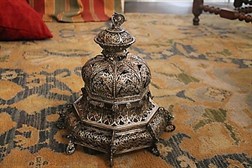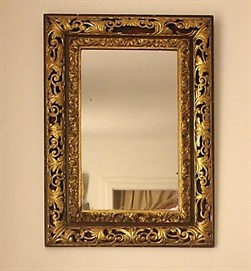Small pieces of furniture: braziers, lamps and mirrors
 In the Spain of the Baroque era, braziers were fully accepted into the category of furniture, as useful but also of great ornamental value and wealth (photo 1. Museo Nacional de Artes DecorativasThis museum contains the material culture of Spanish society, which enables us to interpret the ideas and values of its history. It is located in Madrid’s calle Montalbán. of Madrid). In fact, they not only guaranteed the heating and lighting of the environment, but also made homes more comfortable and gave a good impression of the owner of the house in front of his guests, as a decorative element essential in meetings, gatherings and dinners during the Winter. Compared with the widespread use of iron in earlier times, in the Baroque period the use of bronze and silver to create these objects was common, which were usually hexagonal or octagonal in shape. During the same period chofetas also proliferated, which were small metal or ceramic braziers used to warm hands or for burning aromatic herbs.
In the Spain of the Baroque era, braziers were fully accepted into the category of furniture, as useful but also of great ornamental value and wealth (photo 1. Museo Nacional de Artes DecorativasThis museum contains the material culture of Spanish society, which enables us to interpret the ideas and values of its history. It is located in Madrid’s calle Montalbán. of Madrid). In fact, they not only guaranteed the heating and lighting of the environment, but also made homes more comfortable and gave a good impression of the owner of the house in front of his guests, as a decorative element essential in meetings, gatherings and dinners during the Winter. Compared with the widespread use of iron in earlier times, in the Baroque period the use of bronze and silver to create these objects was common, which were usually hexagonal or octagonal in shape. During the same period chofetas also proliferated, which were small metal or ceramic braziers used to warm hands or for burning aromatic herbs.
The objects used to light the rooms were usually made of silver, and if they were instead made of iron or bronze they were usually covered in gold or silver to embellish them. They could be used at the table as candle holders, on walls to maintain curtains or from the ceiling like chandeliers. The latter, generally bell-shaped cover with silver, were fixed to the ceiling, from which came down between six and eight chains that held the plate decorated with geometric shapes of plants, manufactured in Andalusia.
 Mirrors were less frequent in the seventeenth century than they would be in the following century. Of course, they are present in almost all eighteenth-century wills, indicating a change of habits in the care of personal hygiene and a greater concern for clothing and personal appearance. The mirror marks the triumph of image and appearance and, ultimately, the start of a phase of greater individualism. The seventeenth century is the century of the Baroque however, and therefore the century of mirror games and optical experiments that arouse the interest of European society. In the Spanish case, the paintings appear in various small mirrors that reflect things and people that are not in the picture and the best known example is undoubtedly Diego Velázquez‘s Las Meninas. The multiplication of the mirrors in the decoration of palaces and noble’s mansions (think of the hall of mirrors in the Alcázar de Madrid), had a twofold purpose: thanks to them the courtiers could see themselves as spectators and at the same time as the protagonists of the play at the court. The mirrors of the Spanish Baroque were usually square or rectangular shape, and the material of the frames could be of different types: wood, gilded or not, brass and bronze (photo 2. Museo Nacional de Artes Decorativas of Madrid).
Mirrors were less frequent in the seventeenth century than they would be in the following century. Of course, they are present in almost all eighteenth-century wills, indicating a change of habits in the care of personal hygiene and a greater concern for clothing and personal appearance. The mirror marks the triumph of image and appearance and, ultimately, the start of a phase of greater individualism. The seventeenth century is the century of the Baroque however, and therefore the century of mirror games and optical experiments that arouse the interest of European society. In the Spanish case, the paintings appear in various small mirrors that reflect things and people that are not in the picture and the best known example is undoubtedly Diego Velázquez‘s Las Meninas. The multiplication of the mirrors in the decoration of palaces and noble’s mansions (think of the hall of mirrors in the Alcázar de Madrid), had a twofold purpose: thanks to them the courtiers could see themselves as spectators and at the same time as the protagonists of the play at the court. The mirrors of the Spanish Baroque were usually square or rectangular shape, and the material of the frames could be of different types: wood, gilded or not, brass and bronze (photo 2. Museo Nacional de Artes Decorativas of Madrid).
